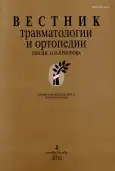Elaboration of New Treatment Methods for Spinal Cord Injuries Using Magnetic Nanoparticles in Combination with Electromagnetic Field (Experimental Study)
- Authors: Kolesov S.V1, Panteleev A.A1, Sazhnev M.L1, Kaz’min A.I1
-
Affiliations:
- N.N. Priorov Central Institute of Traumatology and Orthopaedics
- Issue: Vol 23, No 4 (2016)
- Pages: 55-60
- Section: Original study articles
- URL: https://journals.rcsi.science/0869-8678/article/view/47299
- DOI: https://doi.org/10.17816/vto201623455-60
- ID: 47299
Cite item
Full Text
Abstract
Full Text
##article.viewOnOriginalSite##About the authors
S. V Kolesov
N.N. Priorov Central Institute of Traumatology and Orthopaedicsдоктор мед. наук, профессор, зав. отделением патологии позвоночника ЦИТО Moscow, Russia
A. A Panteleev
N.N. Priorov Central Institute of Traumatology and Orthopaedicsординатор ЦИТО Moscow, Russia
M. L Sazhnev
N.N. Priorov Central Institute of Traumatology and Orthopaedics
Email: mak.sajnev@yandex.ru
кандидат мед. наук, врач отделения патологии позвоночника; Тел.: 8 (495) 450-44-51 Moscow, Russia
A. I Kaz’min
N.N. Priorov Central Institute of Traumatology and Orthopaedicsкандидат мед. наук, врач отделения патологии позвоночника Moscow, Russia
References
- Thuret S., Moon L.F., Gage F.H. Therapeutic interventions after spinal cord injury. Nat. Rev. Neurosci. 2006; 7: 628-43.
- Keirstead H., Pataky D., McGraw J., Steeves J. In vivo immunological suppression of spinal cord myelin development. Brain Res. Bull. 1997; 44: 727-34.
- Nicholls J., Saunders N. Regeneration of immature mammalian spinal cord after injury. Trends Neurosci. 1996; 19: 229-34.
- Galtrey C.M., Fawcett J.W. The role of chondroitin sulfate proteoglycans in regeneration and plasticity in the central nervous system. Brain Res. Rev. 2007; 54: 1-18.
- Busch S.A., Silver J. The role of extracellular matrix in CNS regeneration. Curr. Opin. Neurobiol. 2007; 17: 120-7.
- Plemel J.R., Yong V.W., Stirling D.P. Immune modulatory therapies for spinal cord injury - past, present and future. Exp. Neurol. 2014; 258: 91-104.
- Gensel J.C., Donnelly D.J., Popovich P.G. Spinal cord injury therapies in humans: an overview of current clinical trials and their potential effects on intrinsic CNS macrophages. Expert Opin. Ther. Targets 2011; 15 (4): 505-18.
- Tetzlaff W., Okon E.B., Karimi-Abdolrezaee S., Hill C.E., Sparling J.S., Plemel J.R. A systematic review of cellular transplantation therapies for spinal cord injury. J. Neurotrauma 2010; 28 (8): 1611-82.
- Cadotte D.W., Fehlings M.G. Spinal cord injury: a systematic review of current treatment options. Clin. Orthop. Relat. Res. 2011; 469 (3): 732-41.
- Gorrie C.A., Hayward I., Cameron N., Kailainathan G., Nandapalan N., Sutharsan R. Effects of human OEC-derived cell transplants in rodent spinal cord contusion injury. Brain Res. 2010; 1337: 8-20.
- Agudo M., Woodhoo A., Webber D., Mirsky R., Jessen K.R., McMahon S.B. Schwann cell precursors transplanted into the injured spinal cord multiply, integrate and are permissive for axon growth. Glia. 2008; 56 (12): 1263-70.
- Kim M. Regeneration of completely transected spinal cord using scaffold of poly (D,L-lactide-co-glycolide)/small intestinal submucosa seeded with rat bone marrow stem cells. Tissue Eng. Part A. 2011; 17: 2143-52.
- Park S.I., Lim J.Y., Jeong C.H., Kim S.M., Jun J.A., Jeun S.S. Human umbilical cord blood-derived mesenchymal stem cell therapy promotes functional recovery of contused rat spinal cord through enhancement of endogenous cell proliferation and oligogenesis. J. Biomed. Biotechnol. 2012 (2012). Article ID 362473.
- Franz S., Weidner N., Blesch A. Gene therapy approaches to enhancing plasticity and regeneration after spinal cord injury. Exp. Neurol. 2011; 235: 62-9.
- Suter D.M., Miller K.E. The emerging role of forces in axonal elongation. Progr. Neurobiol. 2011; 94: 91-101.
- Franze K. The mechanical control of nervous system development. Development. 2013; 140: 3069-77.
- Smith D.H. Stretch growth of integrated axon tracts: Extremes and exploitations. Prog. Neurobiol. 2009; 89 (3): 231-9.
- Heidemann S.R., Bray D. Tension-driven axon assembly: a possible mechanism. Front Cell Neurosci. 2015; 9: 316.
- Santo V.E., Rodrigues M.T., Gomes M.E. Contributions and future perspectives on the use of magnetic nanoparticles as diagnostic and therapeutic tools in the field of regenerative medicine. Expert Rev. Mol. Diagn. 2013; 13 (6): 553-66.
- Vanecek V., Zablotskii V., Forostyak S., Ruzicka J., Herynek V. Highly efficient magnetic targeting of mesenchymal stem cells in spinal cord injury. Int. J. Nanomedicine. 2012; 7: 3719-30.
- Bock N., Riminucci A., Dionigi C., Russo A. A novel route in bone tissue engineering: Magnetic biomimetic scaffolds. Acta Biomater. 2010; 6 (3): 786-96.
- Huang H., Delikanli S., Zeng H., Ferkey D.M., Pralle A. Remote control of ion channels and neurons through magnetic-field heating of nanoparticles. Nat. nanotechnol. 2010; 5: 602-6.
- Pankhurst Q.A., Connolly J., Jones S.K., Dobson J. Applications of magnetic nanoparticles in biomedicine. J. Phys. D. Appl. Phys. 2003; 36: R167-81.
- Миронов С.П., Колесов С.В., Степанов Г.А., Сажнев М.Л., Губин С.П., Иони Ю.В., Мотин В.Г., Пантелеев А.А. Моделирование различного по объему повреждения спинного мозга крысы и методы оценки восстановления утраченных функций (часть 1). Вестник травматологии и ортопедии им. Н.Н. Приорова. 2015; 3: 73-7. [Mironov S.P., Kolesov S.V., Stepanov G.A., Sazhnev M.L., Gubin S.P., Ioni Yu.V., Motin V.G., Panteleev A.A. Modeling of a different volume spinal cord injury in rats and methods for evaluation of lost functions restoration (Part 1). Vestnik travmatologii I ortopedii im. N.N. Priorova. 2015; 3: 73-7].
- Basso D.M., Beattie M.S., Bresnahan J.C. A sensitive and reliable locomotor rating scale for open field testing in rats. J. Neurotrauma. 1995; 12: 1-21.
- Nashmi R., Imamura H., Tator C.H., Fehlings M.G. Serial recording of somatosensory and myoelectric motor evoked potentials: Role in assessing functional recovery after graded spinal cord injury in the rat. J. Neurotrauma. 1997; 14: 151-9.
- Ito A., Shinkai M., Honda H., Kobayashi T. Medical application of functionalized magnetic nanoparticles. J. Biosci. Bioeng. 2005; 100: 1-11.
- Pisanic T.R., Blackwell J.D., Shubayev V.I., Finones R.R., Jin S. Nanotoxicity of iron oxide nanoparticle internalization in growing neurons. Biomaterials. 2007; 28 (25): 72-81.
Supplementary files






